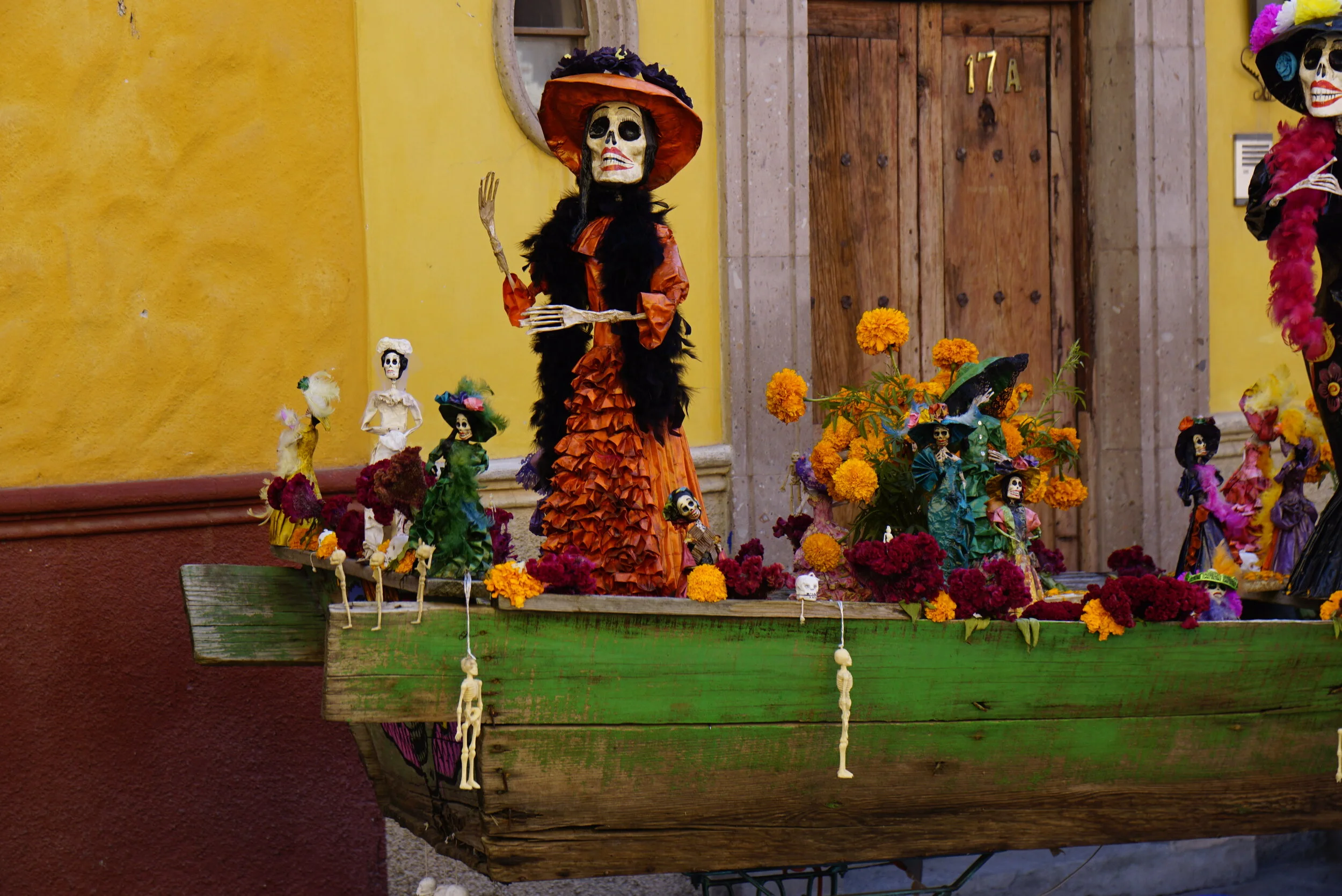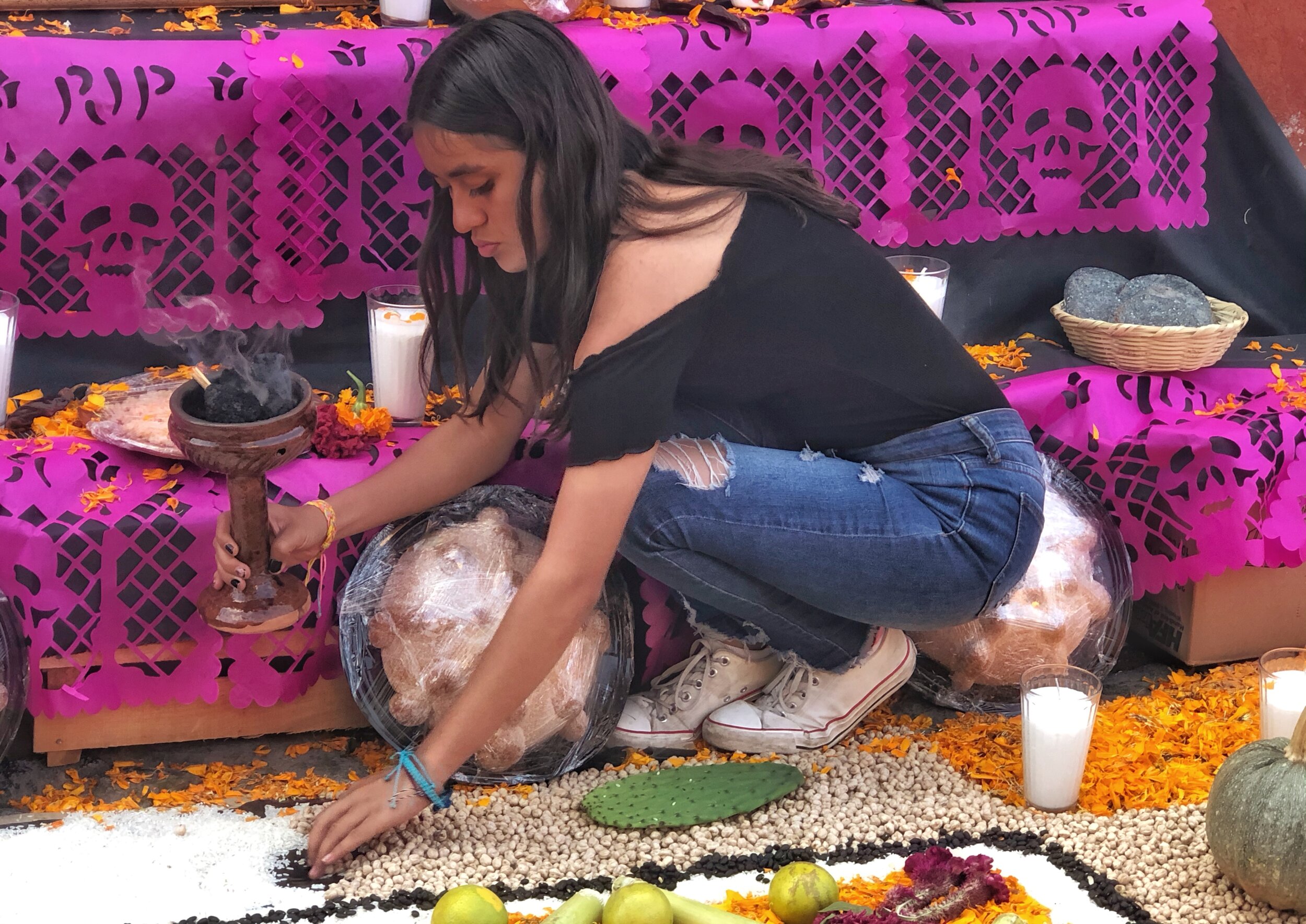In Preparation for the Dia de los Muertos
The Dia de los Muertos or Day of the Dead is a big deal in Mexico. The official day is November 2nd and not October 31st as in our Halloween. To be more specific, there is a day to honor deceased children: November 1st (Also All Saints Day) while November 2nd is for adults. To make things more complicated, the Pre-Columbian commemoration to the dead was in late August during the harvest season.
Upon arriving in San Miguel de Allende in the third week of October, having just basked in New England’s glorious colors, we were greeted by even more vibrant colors such as the ones in the truck above. Preparations were beginning just around the corner from our home. Makeshift stalls displaying papaya and cream colored candles of all sizes, special pastries and breads called Pano de Muerto (Bread of the Dead), along with rows upon rows of decorative pure white sugar candies shaped as oranges, limes, bananas, peppers, tomatoes as well as sheep and cows, and of course, skulls had sprouted overnight in the Plaza Civica. Three 18th century colonial churches: the Oratorio, the Capilla Loreto and Nuestra Signora de la Salud stand like sentries above the stalls with their white canvas tops blowing in the wind.
Soon to come are the flowers, flowers and more flowers delivered to the mercado or sold on the streets. This truck held up traffic while huge bundles of marigolds and cockscombs were being delivered from local as well as distant farms. No one honked. I followed the men carrying the heavy loads on their backs into the mercado where florists do a brisk business year around. This time of year though is probably the busiest.
What is the name for the bright orange marigold, a plant native to Mexico and Central America? I asked a vendor. “Cempasuchil” she responded. (How many times have I had to ask before learning the term??) My friend, Maricela commented on my Facebook photo that this Náhuatl word also spelled Cempoalxóchitl, means “twenty” i.e. cempoalli and flower or xóchitl, used as a woman’s name as well. If the twenty flowers signify petals, I haven’t counted them yet. Perhaps this is because the odor isn’t so appealing. Certain insects don’t particularly go for it either — hence its traditional use in vegetable gardens to ward off pests.
Important to this season though is that both its sunny color — and strong odor will guide the soul back to loved ones albeit for a brief visit.
Almost as significant are the tall, fuschia colored and ever so velvety cockscombs of the Amaranth family. Known in Spanish as Cresta de Gallo (rooster’s crest) or Pata de Leon (lion’s paw), they are a knock-out. Unlike the ubiquitous marigolds planted throughout plazas and in little pots by stores, these sensual flowers, also native to here, make for a striking contrast to the marigolds in a bouquet on an altar. And we are spared their odor…
So what does this elegant flower with a stem the shape of a dull knife blade symbolize? According to some, the blood of Christ. However, in the chronological scheme of things this can only be a recent symbol. As the conquistadores became established in New Spain, ancient cultural and religious beliefs such as the one that focused on the long and complex passage of the soul to the ultimate Land of the Dead or Mictlan, were not entirely suppressed by the Church. And while today we hear that souls are being enticed to pay a visit “back home”, upon more study I learned the offerings or ofrendas such as food were to help the soul on its long and arduous journey to Mictlan.
Below are stalls selling pastries, the Pan de Muerto, candles, and much more to be soon featured in home altars and cemeteries.




By November 1st, we are being greeted by fanciful displays and painted faces. Just below is a “canoe” with the famous Calavera Catrinas (Dapper Skeletons). First created in the early 20th century by the printmaker, José Guadelupe Posada, they were satirical renditions of women aspiring to adopt European aristocratic styles. Today, they are an icon of this season.
humor, the best antidote to death. Photo credit: David Lippman
For more on the Dia de los Muertos, please visit: https://www.honeysharp.com/catrinas-marigolds-altars?rq=Catrinas









